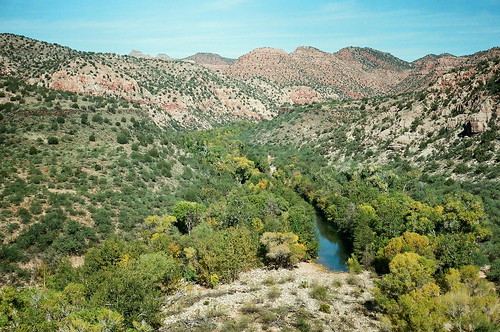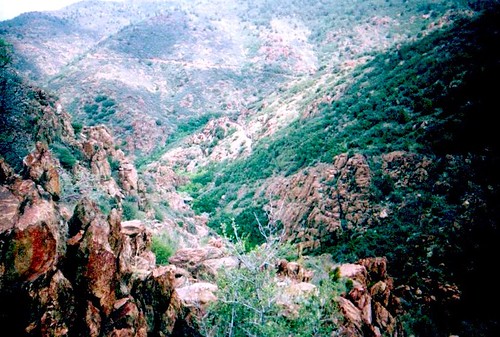The Noise
May 2011
The Outs
Ellen Jo Roberts
The sub-oceanic earthquakes and subsequent tsunamis that struck Japan’s coast this March are a powerful, and terrifying reminder of earth’s forces at work beneath us. Arizonans might feel some semblance of comfort to live in a region free of such dramatic plate tectonics. However, the truth is we are not immune to seismic activity in our state. In fact, there are small tremors occurring all around us all the time. As of press time there have been 19 earthquakes documented in Arizona already this year.
What makes our state’s geology so varied and visually thrilling is also what creates the potential for shocking uplifts, volcanic eruptions, and other dramatic changes to the landscape.

On January 23rd, and again on March 18th 2011, there were two minor earthquakes reported in the vicinity of Sycamore Canyon’s confluence with the Verde River, northeast of Clarkdale and west of Sedona. With magnitudes of 3.6 and 3.7, respectively, and centered deep underground in an area of wilderness, the quakes went mostly unnoticed, except for an assortment of finely attuned Clarkdale residents.
On the date the January quake occurred, a flurry of local chatter stirred up the neighborhood. “Earthquake! Did you feel an earthquake?” The only thing I felt that day seemed like someone slamming a door in some distant part of the building.
(Note: it may have actually been someone slamming a door.)
“These two quakes were likely located on a branch of the Verde fault,” explains David Brumbaugh. Professor of Geology, specializing in Geophysics, at Northern Arizona University, and Director of the Arizona Earthquake Information Center, “The Verde is the large fault that runs along the eastern front of the Black Hills through Jerome.
Earthquakes are measured by seismometers and assigned “moment magnitude scale” numbers based on the measuring formula originally created in 1935 by Charles Richter and Beno Gutenburg of California’s Institute of Technology. The intensity of shaking is measured on the “Modified Mercalli Scale”, with shallower earthquakes causing the most damage. “We use the seismogram itself to estimate size, especially for smaller earthquakes,” explains Professor Brumbaugh, “This method is to use the time from the beginning to the end of the wiggles of an earthquake signature, as an estimate of size. This is called the ‘coda magnitude’ and can be related to the Richter Magnitude. Epicenter locations are determined by the travel time of the earthquake waves from several different stations, which can then be converted to distance.”
According to the various measuring scales, any quakes less than 4.0 magnitude are minor, and below 3.0 are scarcely noticeable, except by sensitive scientific equipment. Above 4.0 the tremors become noticeable to the local population. Knick-knacks and bric-a-brac fall from shelves, loose items rattle. Above 5.0 real damage begins to occur.
As the numbers increase, the scale of the damage and movement increases.
Magnitudes 6.0 to 7.9 are considered “major”. The Loma Prieta Earthquake in California’s Bay Area that disrupted the 1989 World Series, caused freeways to collapse and killed 63 people was a 6.9. At 8, things progress from “great” to “massive”. The 1906 earthquake that decimated San Francisco is debated to have measured between 7.7 and 8.0. Mexico City’s catastrophic 1985 earthquake, which killed 10,000 people, was measured as an 8.1. Its epicenter was in the Pacific Ocean over 200 miles away. The tsunami that hit Indonesia in December 2004 was a result of a 9.3 coastal earthquake. This year’s catastrophic tsunamis devasting Japan resulted from a 9.0 sub-oceanic “Megathrust” earthquake 45 miles off the coast. Megathrust earthquakes generally produce the highest magnitudes, and the most damage, and are caused by converging tectonic plates, as opposed to rumbling fault lines. While the Pacific Coast (and California’s San Andreas Fault running up the state like a zipper) is a well documented as a seismic hot spot, there are frequent minor quakes occurring all the time throughout much of the United States. The New Madrid Fault Line in the Midwestern U.S. has seismic potential to seriously threaten seven states: Illinois, Indiana, Kentucky, Missouri, Arkansas, Tennessee and Mississippi. As a child in Chicago in the 1980s I remember a tremor shaking our neighborhood as a direct result of the New Madrid Fault, hundreds of miles away in Missouri. It felt like our brick bungalow suddenly shuddered, like a dog having a dream.

Here in the southwest, earthquake activity is caused by many faults not even visible, hidden deep below the earth under many layers of sedimentary geology, and granite from volcanic flows. Other faults and breaks are more noticeable, and some glorious uplifts are dramatic landmark geographical features. Most seismic activity in Arizona happens on the Colorado Plateau, and along the “Arizona Strip”, our northern border with Utah. The Grand Canyon, perhaps ever in flux and transition, is also a hot spot for shocks and continuing aftershocks. No earthquake in Arizona history has ever caused a single injury or death, though there have been a few that have inspired great fright.
“The cumulative terror produced by a series of 52 earthquakes, from September 10 to 23, 1910, caused a construction crew in the Coconino Forest near Flagstaff to break camp and leave the area. Boulders rolled down on their camp from nearby mountains, and the earth maintained a constant quiver. The shocks grew in intensity until September 23, when a very strong shock raged throughout northern Arizona. It was so severe north of the San Francisco Mountains that Indians fled from the region.”
- “Seismicity of the United States, 1568-1989 (Revised)”, by Carl W. Stover and Jerry L. Coffman, U.S. Geological Survey Professional Paper 1527
“For an earthquake to cause serious damage in Arizona, it would have to be M6.0 or larger,” says Professor Brumbaugh. One of the largest earthquakes ever documented in Arizona registered at a magnitude of 5.6, and occurred at 5:39pm on July 21st, 1959 along the Arizona-Utah Border near the neighboring cities of Fredonia AZ and Kanab UT.

The tremor caused damage to buildings, breaking windows, walls and toppling chimneys. Store merchandise fell off of shelves, and a rockslide occurred at Grand Canyon’s Mather Point.
The professor also sites three potentially damaging earthquakes in Northern Arizona’s history: an M6.2 in 1906, the same year as San Francisco’s killer quake, an M6.0 in 1910 and an M6.2 in 1912, “Most earthquakes occur in Northern Arizona in a belt extending from Utah to Blue Ridge through Flagstaff known as the ‘Northern Arizona Seismic Belt’,” he explains, “As a worse case scenario, the faults in this seismic belt could generate an earthquake of about M7.0, but this is not very likely. There has not been one this large in historic time.”

When we lived in Jerome, we were often teased that our house might not be there when we got home, that it might “slide down the mountain”, making sport of the town’s steep trajectory, as well as the 88 miles of mining tunnels spidering beneath it.
Back in 1976 there was different concern, as a series of light earthquakes struck the area in February and April of that year. The epicenter of these quakes was about 20 miles northwest of Jerome, in Chino Valley, AZ. Current resident Jane Moore first arrived in Jerome in the early 1970s and she remembers the shocks shaking the historic town.
“I distinctly remember the day, and that I was outside doing something with my horses, who were in a corral down below Rich Street. I didn't feel the first shock too much, being out on the ground, but do remember all of sudden people poking their heads out their windows and saying stuff like ‘What the hell? What's going on?’ and that their houses were rattling and shaking,” Ms. Moore recalls, “Then later that afternoon I was back in my house…and felt an aftershock that shook the house... no damage.”

The Colorado Plateau is home to some of the world’s most amazing landscape, most of it created by violent geological changes such as volcanic activity and shifting plates (the two actions are often times connected). “An active volcanic area like the San Francisco field around Flagstaff is likely to have relatively frequent, but smaller earthquakes,” states Professor Brumbaugh. “But eruptions do not occur very often. Sunset Crater was the most recent, with an eruption about 1,000 years ago. The eruptions in the San Francisco Field have been spaced out every few thousand years so far.”

Other features have been formed by millions of years of slow moving change, such as sediment-depositing floods, receding floods revealing sedimentary sandstone, carving rivers, and gradual uplifts. Below the Mogollon Rim, ancient lakes, effluvial plains and rifts in earth give us gifts like Sedona, the Verde Valley, and fossilized sea creatures embedded at 7,000 feet above Jerome. The ever-changing planet we call home, despite being bound with wires, pipes, antennae, factories, and roads, will never be harnessed completely. The exact things that make planet earth a living, ever-changing organism capable of sustaining life are the exact things that also make it dangerous to its inhabitants. It’s unpredictable, fiery, quarrelsome, sometimes grumpy and dissatisfied. Like us. We too, are a danger right back, changing the earth to suit us, and seldom considering the impact we may have on its future.
For more information on Arizona’s earthquake activity, visit NAU’s Arizona Earthquake Information Center: http://www4.nau.edu/geology/aeic/aeic.html
Ellen Jo Roberts lives in Clarkdale, Arizona with “Bike Daddy” Chad, “Five Pounds of Fury” Floyd, and “Super Spaz” Ivan, and a fine assortment of 1970s Volkswagens.
Read all about it at Ellenjo.com

No comments:
Post a Comment